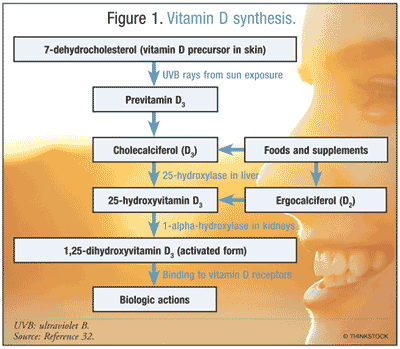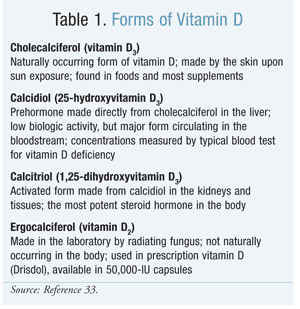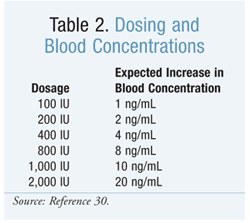How Long Does Vitamin D Stay In Body
US Pharm. 2010;35(10):58-76.
An estimated 1 billion people worldwide, across all ethnicities and age groups, have a vitamin D deficiency.1-3 This is mostly attributable to people getting less sun exposure because of climate, lifestyle, and concerns about skin cancer. The 1997 Dietary Reference Intake (DRI) values for vitamin D, initially established to prevent rickets and osteomalacia, are considered too low by many experts.4 DRI values are 200 IU for infants, children, adults up to age 50 years, and pregnant and lactating women; 400 IU for adults aged 50 to 70 years; and 600 IU for adults older than 70 years. Current studies suggest that we may need more vitamin D than presently recommended to prevent chronic disease. Emerging research supports the possible role of vitamin D in protecting against cancer, heart disease, fractures and falls, autoimmune diseases, influenza, type 2 diabetes, and depression. Many health care providers have increased their recommendations for vitamin D supplementation to at least 1,000 IU.5 As a result, more patients are asking their pharmacists about supplementing with vitamin D.
Pharmacology
Vitamin D is a fat-soluble vitamin that acts as a steroid hormone. The body makes vitamin D from cholesterol through a process triggered by the action of the sun's ultraviolet B rays on the skin (FIGURE 1). Factors such as skin color, age, amount and time of sun exposure, and geographic location affect how much vitamin D the body makes. Vitamin D influences the bones, intestines, immune and cardiovascular systems, pancreas, muscles, brain, and the control of cell cycles.6 Its primary functions are to maintain normal blood concentrations of calcium and phosphorus and to support bone health.

Vitamin D undergoes two hydroxylations in the body for activation. There are several metabolic products or modified versions of vitamin D (TABLE 1). Calcitriol (1,25-dihydroxyvitamin D3), the active form of vitamin D, has a half-life of about 15 hours, while calcidiol (25-hydroxyvitamin D3) has a half-life of about 15 days.6 Vitamin D binds to receptors located throughout the body.6

Deficiency, Blood Concentrations, and Toxicity
Risk factors for vitamin D deficiency include living in northern latitudes (in the U.S., above the line from San Francisco to Philadelphia), failing to get at least 15 minutes of direct sun exposure daily, being African American or dark-skinned, being elderly, or being overweight or obese.5 Rickets and osteomalacia are the well-known diseases of severe vitamin D deficiency. Musculoskeletal pain and periodontal disease may also indicate a significant vitamin D deficiency.7 Subtle symptoms of milder deficiency include loss of appetite, diarrhea, insomnia, vision problems, and a burning sensation in the mouth and throat.7 Drawing a blood calcidiol concentration is the standard test for vitamin D status, since calcidiol has a longer half-life.8
A normal range of vitamin D is 30 to 74 ng/mL, but this can vary among laboratories.8 Most experts agree that a concentration between 35 and 40 ng/mL is reasonable for preventive health. Some suggest that the optimal concentration for protecting against cancer and heart disease is between 50 and 70 ng/mL and up to 100 ng/mL. Side effects or toxicity can occur when blood concentrations reach 88 ng/mL or greater.9 Symptoms include nausea, vomiting, constipation, headache, sleepiness, and weakness.6 Too much vitamin D can raise blood calcium concentrations, and acute toxicity causes hypercalcemia and hypercalciuria.6,9
Disease Prevention
Cancer: Vitamin D decreases cell proliferation and increases cell differentiation, stops the growth of new blood vessels, and has significant anti-inflammatory effects. Many studies have suggested a link between low vitamin D levels and an increased risk of cancer, with the strongest evidence for colorectal cancer. A Creighton University study found that postmenopausal women given 1,100 IU of vitamin D3 (plus calcium) versus placebo were 77% less likely to be diagnosed with cancer over the next 4 years.10 In the Health Professionals Follow-up Study (HPFS), subjects with high vitamin D concentrations were half as likely to be diagnosed with colon cancer as those with low concentrations.11
Some studies have shown less positive results, however. The Women's Health Initiative found that women taking 400 IU of vitamin D3 (plus calcium) versus placebo did not have a lower risk of breast cancer.12 Many critics have argued that this dosage of vitamin D is too low to prevent cancer. A 2006 Finnish study of male smokers found that those with higher vitamin D concentrations had a threefold increased risk for pancreatic cancer, with cigarette smoking not found to be a confounding factor.13 A 2009 U.S. study of men and women (mostly nonsmokers) did not confirm these results, finding no association between vitamin D concentrations and pancreatic cancer overall, except in subjects with low sun exposure.14 In this subgroup, higher versus lower vitamin D concentrations had a positive association with pancreatic cancer.14 A definitive conclusion cannot yet be made about the association between vitamin D concentration and cancer risk, but results from many studies are promising.
Heart Disease: Several studies are providing evidence that the protective effect of vitamin D on the heart could be via the renin-angiotensin hormone system, through the suppression of inflammation, or directly on the cells of the heart and blood-vessel walls. In the Framingham Heart Study, patients with low vitamin D concentrations (<15 ng/mL) had a 60% higher risk of heart disease than those with higher concentrations.15 The HPFS found that subjects with low vitamin D concentrations (<15 ng/mL) were two times more likely to have a heart attack than those with high concentrations (>30 ng/mL).16 In another study, which followed men and women for 4 years, patients with low vitamin D concentrations (<15 ng/mL) were three times more likely to be diagnosed with hypertension than those with high concentrations (>30 ng/mL).17 As is the case with cancer and vitamin D, more studies are needed to determine the role of vitamin D in preventing heart disease, but the evidence thus far is positive.
Fractures and Falls: Vitamin D is known to help the body absorb calcium, and it plays a role in bone health. Also, vitamin D receptors are located on the fast-twitch muscle fibers, which are the first to respond in a fall.18 It is theorized that vitamin D may increase muscle strength, thereby preventing falls.5 Many studies have shown an association between low vitamin D concentrations and an increased risk of fractures and falls in older adults.
A combined analysis of 12 fracture-prevention trials found that supplementation with about 800 IU of vitamin D per day reduced hip and nonspinal fractures by about 20%, and that supplementation with about 400 IU per day showed no benefit.19 Researchers at the Jean Mayer USDA Human Nutrition Research Center on Aging at Tufts University have examined the best trials of vitamin D versus placebo for falls. Their conclusion is that "fall risk reduction begins at 700 IU and increases progressively with higher doses."18 Overall, the evidence is strong in support of supplementing with vitamin D to prevent fractures and falls.
Autoimmune Diseases and Influenza: Since vitamin D has a role in regulating the immune system and a strong anti-inflammatory effect, it has been theorized that vitamin D deficiency could contribute to autoimmune diseases such as multiple sclerosis (MS), type 1 diabetes, rheumatoid arthritis, and autoimmune thyroid disease. Scientists have suggested that vitamin D deficiency in the winter months may be the seasonal stimulus that triggers influenza outbreaks in the winter.20 Numerous trials have evaluated the association between vitamin D and immune-system diseases.
A prospective study of white subjects found that those with the highest vitamin D concentrations had a 62% lower risk of developing MS versus those with the lowest concentrations.21 A Finnish study that followed children from birth noted that those given vitamin D supplements during infancy had a nearly 90% lower risk of developing type 1 diabetes compared with children who did not receive supplements.22 In a Japanese randomized, controlled trial, children given a daily vitamin D supplement of 1,200 IU had a 40% lower rate of influenza type A compared with those given placebo; there was no significant difference in rates of influenza type B.23 More studies of the influence of vitamin D on immunity will be emerging, as this is an area of great interest and it remains unclear whether there is a link.
Type 2 Diabetes and Depression: Some studies have shown that vitamin D may lower the risk of type 2 diabetes, but few studies have examined the effect of vitamin D on depression. A trial of nondiabetic patients aged 65 years and older found that those who received 700 IU of vitamin D (plus calcium) had a smaller rise in fasting plasma glucose over 3 years versus those who received placebo.24 A Norwegian trial of overweight subjects showed that those receiving a high dose of vitamin D (20,000 or 40,000 IU weekly) had a significant improvement in depressive symptom scale scores after 1 year versus those receiving placebo.25 These results need to be replicated in order to determine a correlation between vitamin D and the risk of diabetes or depression.
Dosing
Only a few foods are a good source of vitamin D. These include fortified dairy products and breakfast cereals, fatty fish, beef liver, and egg yolks. Besides increasing sun exposure, the best way to get additional vitamin D is through supplementation. Traditional multivitamins contain about 400 IU of vitamin D, but many multivitamins now contain 800 to 1,000 IU. A variety of options are available for individual vitamin D supplements, including capsules, chewable tablets, liquids, and drops. Cod liver oil is a good source of vitamin D, but in large doses there is a risk of vitamin A toxicity.26
The two forms of vitamin D used in supplements are D2 (ergocalciferol) and D3 (cholecalciferol). D3 is the preferred form, as it is chemically similar to the form of vitamin D produced by the body and is more effective than D2 at raising the blood concentration of vitamin D.27 Since vitamin D is fat soluble, it should be taken with a snack or meal containing fat. In general, 100 IU of vitamin D daily can raise blood concentrations 1 ng/mL after 2 to 3 months (TABLE 2).28 Once the desired blood concentration is achieved, most people can maintain it with 800 to 1,000 IU of vitamin D daily.28 Even though dosages up to 10,000 IU daily do not cause toxicity, it generally is not recommended to take more than 2,000 IU daily in supplement form without the advice of a health care provider.29 Individuals at high risk for deficiency should have a vitamin D blood test first; a dosage of up to 3,000 to 4,000 IU may be required to restore blood concentrations.29

Drug Interactions
Vitamin D supplements may interact with several types of medications. Corticosteroids can reduce calcium absorption, which results in impaired vitamin D metabolism.6 Since vitamin D is fat soluble, orlistat and cholestyramine can reduce its absorption and should be taken several hours apart from it.6 Phenobarbital and phenytoin increase the hepatic metabolism of vitamin D to inactive compounds and decrease calcium absorption, which also impairs vitamin D metabolism.6
Future Research
While considerable research supports the importance of vitamin D beyond bone health, further trials are required before broad claims can be made about vitamin D and prevention of chronic disease. The Institute of Medicine (IOM) is reviewing the research on vitamin D and plans to report in late 2010 regarding any updates to the DRIs for vitamin D (and calcium).30 Specifically, the IOM will consider the relation of vitamin D to cancer, bone health, and other chronic diseases.30 An important study, the Vitamin D and Omega-3 Trial, was launched in early 2010 to determine whether 2,000 IU of vitamin D3 and 1,000 mg of EPA (eicosopentaenoic acid) plus DHA (docosahexaenoic acid) daily can lower the risk of cancer, heart disease, stroke, and other diseases.31 This randomized trial, which will enroll about 20,000 healthy men and women, should provide more insight on vitamin D supplementation.
Conclusion
As the number of people with vitamin D deficiency continues to increase, the importance of this hormone in overall health and the prevention of chronic diseases is at the forefront of research. The best evidence for the possible role of vitamin D in protecting against cancer comes from colorectal cancer studies. Evidence also is strong for the potential role of vitamin D in preventing fractures and falls. At this time, further studies are needed to evaluate the role of vitamin D in protecting against heart disease, autoimmune diseases, influenza, diabetes, and depression.
REFERENCES
1. Holick MF. Vitamin D deficiency. N Engl J Med. 2007;357:266-281.
2. Gordon CM, DePeter KC, Feldman HA, et al. Prevalence of vitamin D deficiency among healthy adolescents. Arch Pediatr Adolesc Med. 2004;158:531-537.
3. Lips P, Hosking D, Lippuner K, et al. The prevalence of vitamin D inadequacy amongst women with osteoporosis: an international epidemiological investigation. J Intern Med. 2006;260:245-254.
4. Standing Committee on the Scientific Evaluation of Dietary Reference Intakes Food and Nutrition Board, Institute of Medicine. Dietary Reference Intakes for Calcium, Phosphorus, Magnesium, Vitamin D, and Fluoride. Chapter 7. Vitamin D. www.nal.usda.gov/fnic/DRI//DRI_Calcium/250-287.pdf. Accessed August 2, 2010.
5. Harvard School of Public Health Nutrition Source. Vitamin D and health. www.hsph.harvard.edu/nutritionsource/what-should-you-eat/vitamin-d/index.html. Accessed August 30, 2010.
6. NIH Office of Dietary Supplements. Dietary supplement fact sheet: vitamin D. http://ods.od.nih.gov/factsheets/vitamind.asp. Accessed August, 4, 2010.
7. Nair S. Symptoms of low vitamin D levels. www.buzzle.com/articles/symptoms-of-low-vitamin-d-levels.html. Accessed September 2, 2010.
8. MedlinePlus. 25-hydroxy vitamin D test. www.nlm.nih.gov/medlineplus/ency/article/003569.htm. Accessed August 4, 2010.
9. Moyad MA. Vitamin D: a rapid review: side effects and toxicity. www.medscape.com/viewarticle/589256_10. Accessed September 2, 2010.
10. Lappe JM, Travers-Gustafson D, Davies KM, et al. Vitamin D and calcium supplementation reduces cancer risk: results of a randomized trial. Am J Clin Nutr. 2007;85:1586-1591.
11. Ahn J, Peters U, Albanes D, et al. Serum vitamin D concentration and prostate cancer risk: a nested case-control study. J Natl Cancer Inst. 2008;100:796-804.
12. Chlebowski RT, Johnson KC, Kooperberg C, et al. Calcium plus vitamin D supplementation and the risk of breast cancer. J Natl Cancer Inst. 2008;100:1581-1591.
13. Stolzenberg-Solomon RZ, Vieth R, Azad A, et al. A prospective nested case-control study of vitamin D status and pancreatic cancer risk in male smokers. Cancer Res. 2006;66:10213-10219.
14. Stolzenberg-Solomon RZ, Hayes RB, Horst RL, et al. Serum vitamin D and risk of pancreatic cancer in the Prostate, Lung, Colorectal, and Ovarian Screening Trial. Cancer Res. 2009;69:1439-1447.
15. Wang TJ, Pencina MJ, Booth SL, et al. Vitamin D deficiency and risk of cardiovascular disease. Circulation. 2008;117:503-511.
16. Giovannucci E, Liu Y, Hollis BW, Rimm EB. 25-Hydroxyvitamin D and risk of myocardial infarction in men: a prospective study. Arch Intern Med. 2008;168:1174-1180.
17. Forman JP, Giovannucci E, Holmes MD, et al. Plasma 25-hydroxyvitamin D levels and risk of incident hypertension. Hypertension. 2007;49:1063-1069.
18. Liebman B. From sun & sea: new study puts vitamin D & omega-3s to the test. Nutrition Action Healthletter. November 2009:3-7.
19. Bischoff-Ferrari HA, Willett WC, Wong JB, et al. Prevention of nonvertebral fractures with oral vitamin D and dose dependency: a meta-analysis of randomized controlled trials. Arch Intern Med. 2009;169:551-561.
20. Cannell JJ, Vieth R, Umhau JC, et al. Epidemic influenza and vitamin D. Epidemiol Infect. 2006;134:1129-1140.
21. Munger KL, Levin LI, Hollis BW, et al. Serum 25-hydroxyvitamin D levels and risk of multiple sclerosis. JAMA. 2006;296:2832-2838.
22. Hyppönen E, Läärä E, Reunanen A, et al. Intake of vitamin D and risk of type 1 diabetes: a birth-cohort study. Lancet. 2001;358:1500-1503.
23. Urashima M, Segawa T, Okazaki M, et al. Randomized trial of vitamin D supplementation to prevent seasonal influenza A in schoolchildren. Am J Clin Nutr. 2010;91:1255-1260.
24. Pittas AG, Harris SS, Stark PC, Dawson-Hughes B. The effects of calcium and vitamin D supplementation on blood glucose and markers of inflammation in nondiabetic adults. Diabetes Care. 2007;30:980-986.
25. Jorde R, Sneve M, Figenschau Y, et al. Effects of vitamin D supplementation on symptoms of depression in overweight and obese subjects: randomized double blind trial. J Intern Med. 2008;264:599-609.
26. Cannell JJ, Vieth R, Willett W, et al. Cod liver oil, vitamin A toxicity, frequent respiratory infections, and the vitamin D deficiency epidemic. Ann Otol Rhinol Laryngol. 2008;117:864-870.
27. HealthTree.com. Vitamin D and calcium supplements. www.healthtree.com/articles/vitamin-d/source/supplement. Accessed September 2, 2010.
28. Moyad MA. Vitamin D: a rapid review: dosage of vitamin D needed to achieve 35 to 40 ng/ml (90-100 nmol/L). www.medscape.com. Accessed August 4, 2010.
29. The Nutrition Source. Ask the expert: vitamin D and chronic disease. www.hsph.harvard.edu/nutritionsource. Accessed August 4, 2010.
30. Institute of Medicine. Dietary Reference Intakes for vitamin D and calcium. www.iom.edu/Activities/Nutrition/DRIVitDCalcium.aspx. Accessed August 2, 2010.
31. The Vitamin D and Omega-3 Trial (VITAL). www.vitalstudy.org. Accessed August 2, 2010.
32. Lau AH, How PP. The role of the pharmacist in the identification and management of secondary hyperparathyroidism. US Pharm. 2007;32(7):62-72.
33. Cannell JJ. Vitamin D pharmacology. www.vitamindcouncil.org/vitaminDPharmacology.shtml. Accessed August 30, 2010.
To comment on this article, contact rdavidson@uspharmacist.com.
How Long Does Vitamin D Stay In Body
Source: https://www.uspharmacist.com/article/vitamin-d-supplementation-an-update


0 Komentar